|
 |
|
 |
|
|
In the popular mind, from the time of
Jeremiah onwards, balm is automatically
associated with Gilead. But there is
no evidence for balm-producing trees or
shrubs having grown in Gilead, a territory
inhabited by the Israelites east of the
River Jordan.
|
|
In ancient days a principal international
trade route called the King's Highway passed
through Gilead which may account for balm
being present there, as an item of commerce.
In the Book of Genesis, after Joseph's
brothers threw him into a dry pit, they sat
down to eat their falafel sandwiches (just
kidding!) and as they looked up, they saw a
company of Ishmaelites coming from Gilead
with camels bearing spices, balm and myrrh,
heading towards Egypt. Seeing the
caravan, Joseph's half-brother Judah then
suggested it would be more profitable to
take Joseph out of the pit and sell him to
the traders. |
|
|
|
But in the meantime Midianite traders had
passed by the pit and heard Joseph's cries
for help. They rescued him and sold
him to presumably the very same Ishmaelites.
Thus Joseph ended up in Egypt along with the
spices, balm and myrrh. When Joseph's
brothers returned to the pit and saw it was
empty, they concluded he was dead, carried
off by a wild animal. (Genesis 37) |
|
|
|
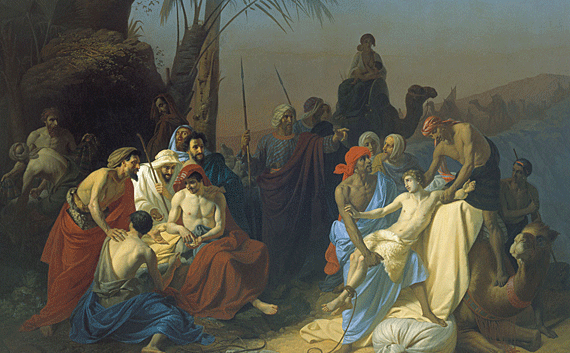 |
|
Konstantin
Flavitsky 1855 in the public domain |
|
19th century painting of
Joseph being sold off into Slavery |
|
|
|
As years pass by and a famine intensified in
Canaan, the patriarch Jacob had no choice
but to send his surviving sons for a second
time to Egypt to beg for food. The
brothers had already gone once and the
governor in charge of dispensing food from
the Egyptian warehouses (i.e. Joseph whom
they didn't recognize) took Simeon as a
hostage. |
|
|
|
The governor told them that if he ever saw
their faces again without their younger
brother (Benjamin) who had been left home he
would imprison them all. Thus Jacob
had no choice but to send Benjamin along
with his older brothers to redeem Simeon and
buy grain for the family. |
|
|
|
In order to sweeten the mood of the
governor, Jacob told his sons to take a
special present of "a little balm and a
little honey, spices and myrrh, pistachio
nuts and almonds." (Genesis 43:11) |
|
|
|
If we fast forward now, to the time of
Jesus, the balm tree of Judea (also called
balsam) was praised by local and foreign
writers such as Josephus, Pliny, Strabo and
Tacitus. Talmudic rabbis identified
Jeremiah's balm of Gilead with this balsam,
extolling its miraculous qualities. |
|
|
|
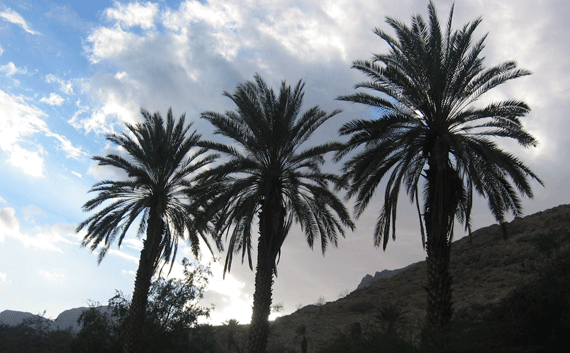 |
|
Photo: Gila
Yudkin |
|
En Gedi was renowned for
its balsam...and date palms |
|
|
|
Balm from En Gedi (and Jericho) was used as
an ingredient in the holy oil for the
Temple, as a healing agent for wounds and as
an antidote to snake bites and scorpion
stings. It's said that
Cleopatra even brought some balm
plants back to Egypt for cultivation. |
|
|
|
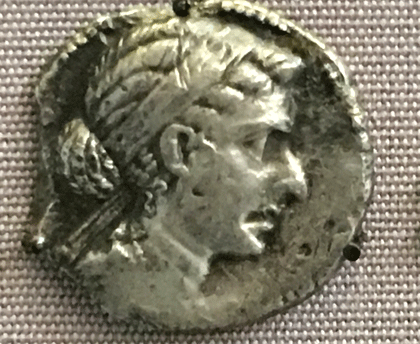 |
|
Courtesy of
the British Museum |
|
Coin with portrait of
Queen Cleopatra minted in
Ashkelon |
|
|
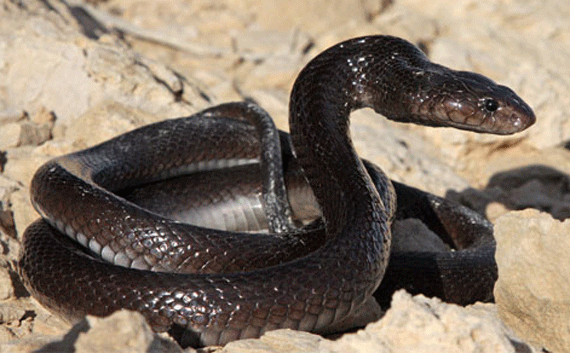 |
|
Courtesy of
Wikipedia Commons |
|
The Balm of Gilead from En
Gedi was a popular antidote to snake bites |
|
|
|
The most notorious use of balm, however, was
for perfume. The pungent resin was
extracted and squeezed from the balm plant
to form an oil or paste. Then by a
highly guarded process, the balsam produced
an exotic powerful fragrance, known and
valued throughout the Roman Empire. |
|
|
|
The rabbis complained about the daughters of
Jerusalem who put myrrh and balsam in their
shoes and walked about the marketplaces of
Jerusalem. "Coming upon the young men
of Israel, the maidens would kick up their
feet, spurting the perfume, thus instilling
the men with passionate desire like with
serpent's poison." (From the
Babylonian Talmud), |
|
|
|
It seems that balsam or balm perfume was
being produced in En Gedi for 600 years
before the time of Jesus. Excavations at En
Gedi have uncovered a 7th or 6th century BC
workshop complete with furnaces and clay
jars, juglets and decanters used for the
distillation of oils in the production of
perfume. |
|
|
|
 |
|
Photo: Gila
Yudkin |
|
Oasis of En Gedi above the
western shore of the Dead Sea |
|
|
|
 |
|
Photo: Gila
Yudkin |
|
Ibex roam freely at En
Gedi, even today |
|
|
|
Some scholars believe that the balm tree was
first introduced to En Gedi as seedlings
brought by the Queen of Sheba. In
First Kings 10 we read that the Queen of
Sheba presented Solomon the wise with 120
talents of gold and great quantities of
spices and precious stones. First
century AD historian Josephus tells us in
his Antiquities of the Jews that one of the
most valuable spices was balsam. |
|
|
|
But it is also possible that a species of
balm may have grown wild in the En Gedi
oasis along with other wild tropical trees.
And eventually residents of En Gedi began
experiments to cultivate the plant so it
produced its pungent resin. |
|
|
|
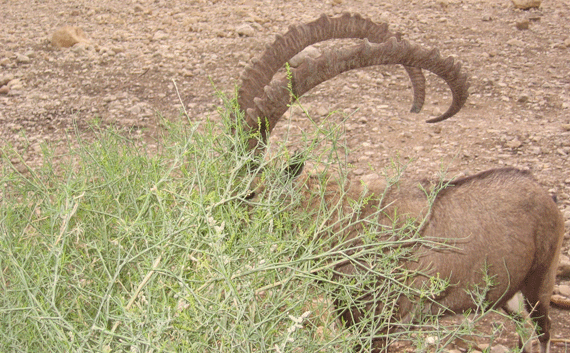 |
|
Photo: Gila
Yudkin |
|
Granddaddy ibex munching
on an En Gedi shrub |
|
|
|
In the year 70 AD when the Roman army
approached the balsam-producing areas of En
Gedi, the Judeans tried to chop down the
trees to prevent their falling into the
hands of their enemies. But in vain. Along with the golden menorah looted from
the Jerusalem Temple, Roman general Titus
displayed branches of balsam trees in his
triumphant victory parade in Rome. |
|
|
|
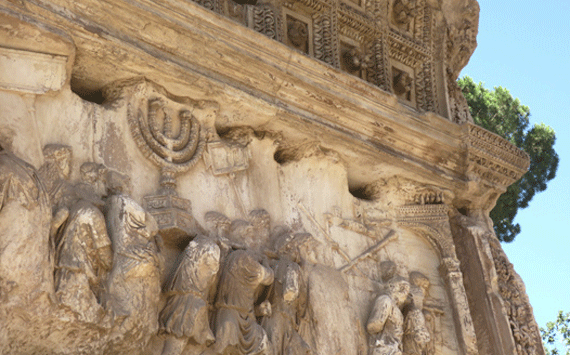 |
|
Photo: Gila
Yudkin |
|
"Victory over Judea"
portrayed on the Arch of Titus in the Roman
Forum |
|
|
|
The best place at En Gedi to tell the story
of the medicinal and fragrant balm is in the
quiet, off the beaten track, charming 4th
century synagogue near the nature reserve.
It is normally so uncrowded that in the
springtime one can inhale the fragrance of
the Judean oasis. |
|
|
|
 |
|
Photo: Gila
Yudkin |
|
Two young ibex outside the
ancient En Gedi synagogue |
|
|
|
 |
|
Photo
courtesy of Silvia Hess |
|
Note how close the
synagogue (under the canvas) is to the Dead
Sea |
|
|
|
|
|
Long after the Romans conquered the land,
balsam was apparently still cultivated at En
Gedi. We know this from the mosaic floor of
the synagogue with a long inscription in
Aramaic. Besides naming the signs of the
zodiac and the genealogy from Adam to Noah's
sons, there is a curse upon "whoever shall
reveal the secret of the town to the
Gentiles."
|
|
|
|
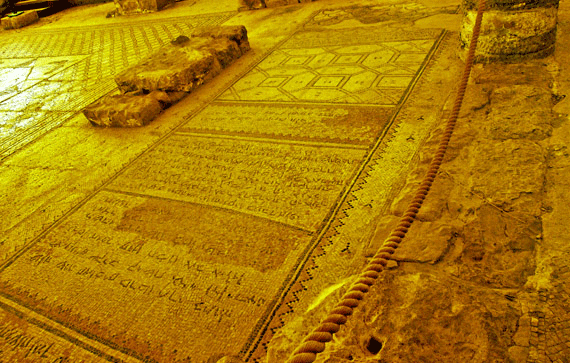 |
|
Photo
courtesy of Silvia Hess |
|
En Gedi Synagogue
Inscription alluding to the "secret of the
town" |
|
|
|
But what's the secret of the town? We think
it is the special method En Gedi farmers
used to grow the balm so it produced the En
Gedi brand of balsam perfume and medicine. This trade secret was the source of
tremendous profits for the community and
guarded zealously, passed down from father
to son. |
|
|
|
And the curse? That I will reveal when we
visit En Gedi on your next pilgrimage. |
|
|
|
In the meantime I will leave you humming, |
|
 |
|
|
"There is a balm in Gilead to make the
wounded whole
There is a balm in Gilead to heal the
sin-sick soul." |
|
|
|
Copyright 2019 Gila Yudkin. Permission
needed for any reuse. |
|
|
|
Gila Yudkin, who calls herself a
Connecticut-born Yankee living in King
David's court, has been asked about the balm
of Gilead on every tour she has led in the
past forty years. She is happy to announce
that she recently discovered that the
excavated synagogue at En Gedi (complete
with a Seat of Moses see Matthew 23:2) is
a perfect place to share this modern theory. |
|
|
|
When Gila first began to guide in En Gedi,
it was famous for its wild leopards.
Unfortunately they did not survive into the
twenty-first century. The leopard is the
only one of the "Big Five" that Gila, an
avid safari-traveler, has not seen up close
and personal. She is hoping at least a
couple will return to En Gedi before she
retires!!! |
|
|
|
When will Gila retire? Well that depends upon
whether modern science can find a worthy
equivalent of the Balm of Gilead! |
|
|
|
Last October on safari in South Africa, Gila
spied a lion lying on the side of the road.
She thought he was dead until he turned
over, scratched his belly and yawned. The
lion reminded her of the amphitheater in
Beth Shean where gladiators once fought
lions. (See
www.itsgila.com/highlightslions.htm) Jeremiah, who told us about the balm of
Gilead, also mentioned lions roaming in the
thickets of the Jordan. (Jeremiah chapters
49 & 50) |
|
|
|
Alas, just like the balm of Gilead, holy
land lions
are extinct today. |
|
|
|
 |
|
Photo: Gila
Yudkin |
|
Unfortunately today there
are no more lions lying in the thickets of
the Jordan! |
|
|
|
But we still have poisonous biblical snakes
in the holy land! Read more about them
in "Let's
not get bitten by poisonous biblical snakes."
When Gila wrote the highlight, she had never
seen a holy land poisonous snake. But
her good friend Miriam
just last summer faced a Palestinian viper.
During an outrageous heat wave, the viper
was coiled around a large clay pot on her
porch in a Jerusalem suburb! But not
to worry. She called a professional snake
catcher who arrived within twenty minutes!
So
holy land poisonous snakes are definitely not extinct!
Look at a photo of a swinging twenty-first
century
poisonous biblical snake. |
|
|
|
There is more to see at
En Gedi than the
ancient synagogue with its mysterious
inscription and seat of Moses. There's
a hike to a waterfall and there are lots of
ibex and conies to scout out. |
|
|
|
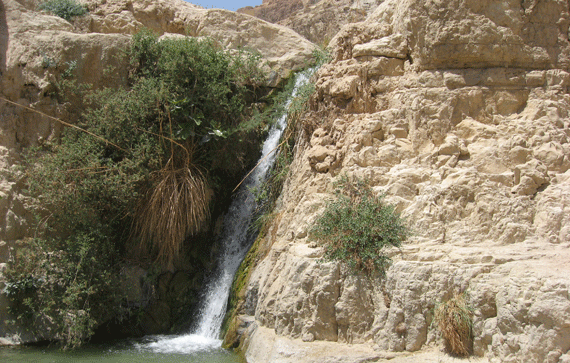 |
|
Photo: Gila
Yudkin |
|
Waterfall at En Gedi oasis |
|
|
|
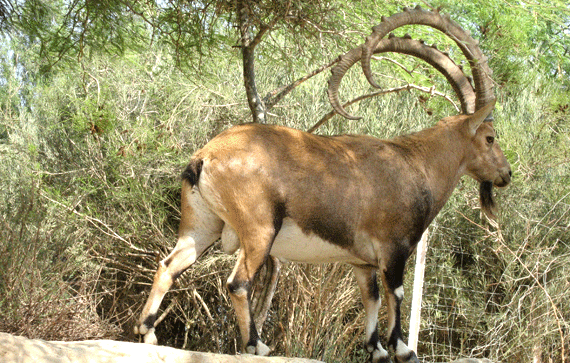 |
|
Photo: Gila
Yudkin |
|
Ibex of all sizes and ages roam the
biblical oasis of En Gedi |
|
|

